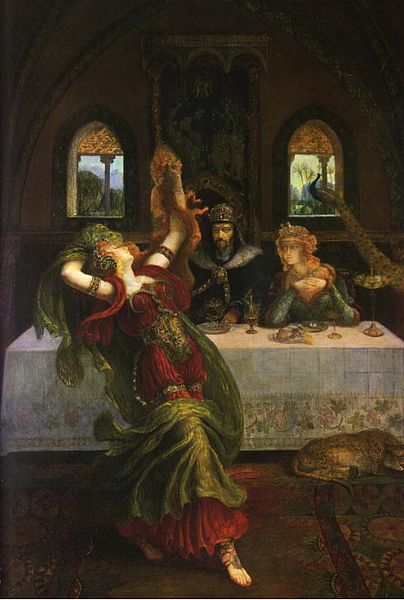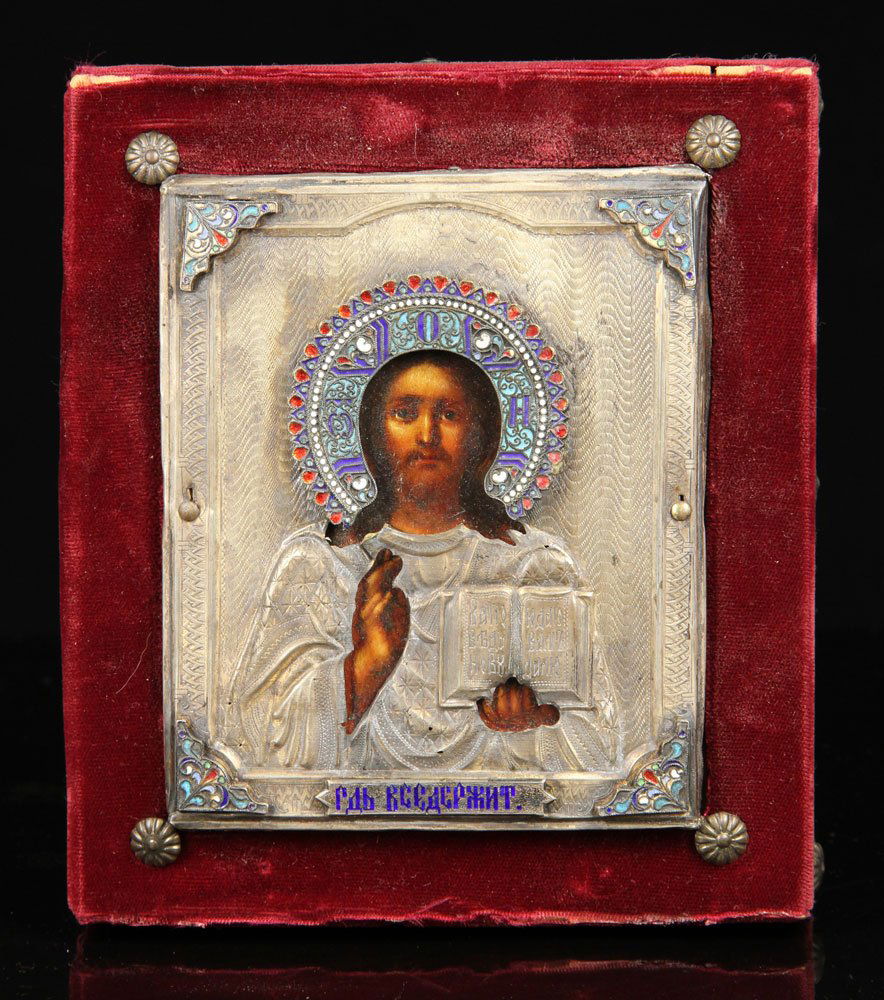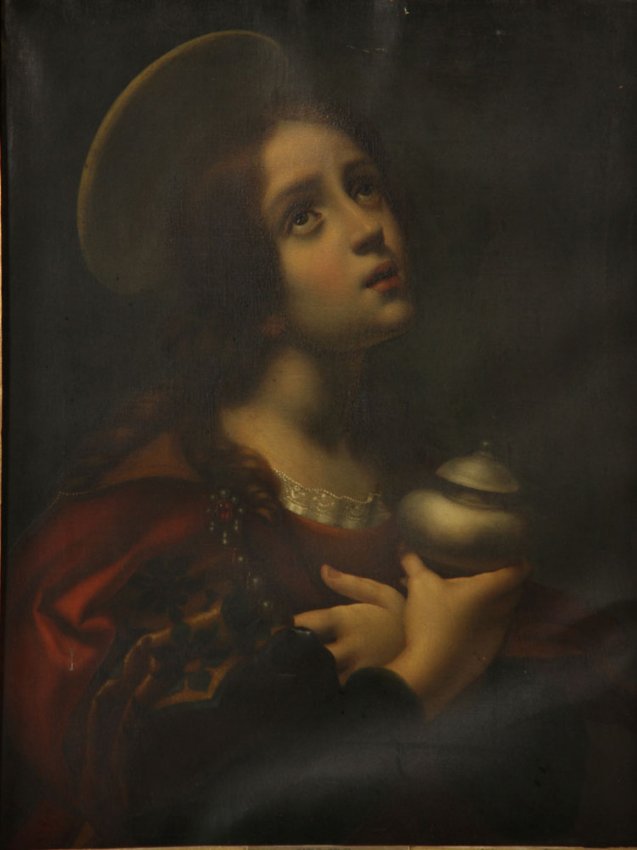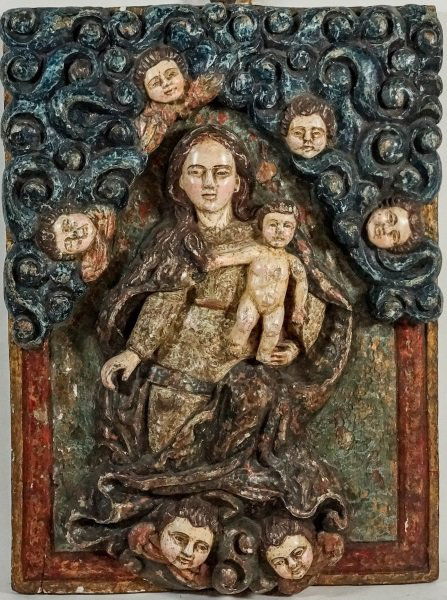Circle of Pieter Coecke van Aelst I (Aalst 1502-1550 Brussels)
The Last Supper
oil on panel
59 x 200 cm
Pieter Coecke van Aelst or Pieter Coecke van Aelst the Elder (August 14, 1502 – December 6, 1550) was a Flemish painter, sculptor, architect and a designer of woodcuts, stained glass and tapestries. His principal subjects are Christian religious themes. He worked in Antwerp and Brussels and was court painter to Charles V, Holy Roman Emperor.
His Last Supper was one of the most popular images of the sixteenth century. It was freely inspired by Leonardo da Vinci's Last Supper in Milan and Marcantonio Raimondi's engraving after Raphael's drawing of the same subject. The gestures of the apostles are based on a print by Albrecht Dürer of 1523. There exist about 45 versions of this composition, which were executed with the assistance of workshop assistants. A great number of the versions are dated, and 6 or 7 date to 1528. The Last Supper probably originated as a drawn model, which was then transferred to a panel by means of cartoons. The composition could be ordered in two formats: 50 x 60 cm and 60 x 80 cm. The large format appears to have been the most popular. Small biblical scenes are depicted in the background, heightening the impact of the main theme. Through the window an Antwerp archway we can see the Entry in Jerusalem of Jesus Christ. Depictions of the Fall of Man are visible in the ornamented window. The medals represent the stories of David and Goliath and the Slaying of Cain. The scene with Cain and Abel is taken directly from a print by another popular Renaissance artist, Jan Gossaert. The whole iconography accentuates the Christian occupation with original sin and mankind's salvation through Christ's sacrifice. More
Studio of Adriaen Isenbrant
The Virgin and Child enthroned, attended by angels, before an open window with a hilly river landscape beyond
oil on panel
42.8 x 32.8 cm.
Adriaen Isenbrandt (1480 and 1490 – July 1551) was a Flemish Northern Renaissance painter, who from documentary evidence was clearly a significant artist of his period, but to whom no specific works can be clearly documented. As hypothesised by art historians, he ran a large workshop specializing in religious subjects and devotional paintings, painting conservatively in the tradition of Early Netherlandish painting. He is believed by some to be the anonymous Master of the Seven Sorrows of the Virgin. Other art historians doubt that any works can be reliably attributed to him, and the number of paintings attributed to him by major museums has been in decline for many decades. More

Lovis Corinth, 1858 - 1925
GERMAN
SUSANNA IM BADE
signed Lovis Corinth, and dated 1890 (lower right)
oil on canvas
63 by 44 in.
159 by 111.8 cm
In the Book of Daniel, Susanna, a married woman, is spied upon by two lustful elders while bathing. As she returns to her home, they accost her, threatening to claim that she was meeting a young man in the garden unless she succumbs to their advances. She refuses to be blackmailed and is consequently arrested and tried for promiscuity, until Daniel interrupts the proceedings in her defense and reveals the truth about the elders. Since the Renaissance, this narrative has provided inspiration for artists to draw upon and convey themes of innocence and culpability, as well as an occasion to paint a nude figure within the context of a history painting. The subject is portrayed by such masters as Peter Paul Rubens, Anthony van Dyck, Artemisia Gentileschi, Pablo Picasso, Thomas Hart Benton and, in the present work, Lovis Corinth, whose rendering was inspired by Jean-Jacques Henner’s earlier composition, Chaste Susannah (1864, Musée d’Orsay), see below, which Corinth would have known from the collection of the Musée de Luxembourg.
While Henner’s painting was highly criticized at the Salon for the inelegant pose of the model and the thinness of the veil offered by the historical subject (see below), Corinth’s submission nearly thirty years later almost abandons the narrative alibi altogether, including elements such as the curtain and peering heads of the Elders anecdotally. The frank presentation of his model sympathizes with the realist nudes of Gustave Courbet. As Andrea Bärnreuther suggests: “It was Corinth’s objective to free the nude of the conventional formulas that had so long determined and limited its presentation and so to restore life to hollow figures drained of all sensuality” (Lothar Brauner and Andrea Bärnreuther, Lovis Corinth, p. 106).
There are two versions of Corinth’s Susanna of 1890; the present, primary composition, which he exhibited at the Salon of 1891 and untraced until recently, and the second version in the collection of the Folkwang Museum, Essen, Germany. Corinth would return to the subject throughout the subsequent decades in his career, including versions dating from 1897, 1909 and 1923, next, revealing his changing perspective on the narrative and his evolution as an artist. The composition also served as the basis for an etching made in 1920.
Lovis Corinth
Susanna and the Elders, c. 1923
Height: 148 cm (58.27 in.), Width: 108 cm (42.52 in.)
Oil on canvas
Niedersächsisches Landesmuseum
Jean-Jacques Henner (1829-1905)
Chaste Suzanne, c. 1864
Oil on canvas
H. 185; W. 130 cm
Paris, Musée d'Orsay
The Biblical episode of Suzanne bathing, often treated since the Renaissance, was above all an opportunity for the artist to paint a handsome nude. This aim became clear in Henner's version of the theme of which he sent back to France in the last year of his residence at the Villa Medicis. For this compulsory exercise, supposed to demonstrate the student's progress and skill in execution, he naturally took his inspiration from prestigious examples left by the great masters in the eternal city. The study of Suzanne Bathing by Guerchino (Colonna Gallery) and Titian's Sacred Love and Profane Love supplied the original idea.
His work was severely criticised particularly for the heaviness and lack of nobility in the model's body. Worse still, for the artificiality of the subject which, on the pretext of being a history painting, showed no more than a simple bather. This tendency to get rid of any narrative alibi in painting the nude, treating it as a subject in itself, could be found in the work of many contemporary artists, starting with Courbet.
Henner's Suzanne is nonetheless a vigorously modelled, sturdily built young woman well set off by the drapery. A prelude in a way to a long series of female figures with pearly complexions, delicately detached from twilight landscapes, a motif which Henner treated over and over again. More
Jean-Jacques Henner (15 March 1829 – 23 July 1905) was a French painter, noted for his use of sfumato and chiaroscuro in painting nudes, religious subjects, and portraits. He was born at Bernwiller (Alsace). He began his studies in art as a pupil of Michel-Martin Drolling and François-Édouard Picot. In 1848, he entered the École des Beaux Arts in Paris, and took the Prix de Rome with a painting of Adam and Eve finding the Body of Abel in 1858. In Rome, he was guided by Flandrin, and painted four pictures for the gallery at Colmar among other works.
He first exhibited Bather Asleep at the Salon in 1863 and subsequently contributed Chaste Susanna (1865), now in the Musée d'Orsay. Other noted works include: Byblis turned into a Spring (1867); The Magdalene (1878); Portrait of M. Hayem (1878); Christ Entombed (1879); Saint Jerome (1881); Herodias (1887); A Study (1891); Christ in His Shroud and a Portrait of Carolus-Duran (1896); a Portrait of Mlle Fouquier (1897); and The Dream (1900).
The Levite of the Tribe of Ephraim (1898) was awarded a first-class medal. Among other professional distinctions, Henner also took a Grand Prix for painting at the Paris Exposition Universelle of 1900. He was made Chevalier of the Legion of Honour in 1873, Officer in 1878, and Commander in 1889. In 1889, he succeeded Cabanel in the Institut de France.
Henner died at age 76 in Paris. More

Leonardo da Vinci
Madonna Litta.
tempera and oil on panel, transferred to canvas.
42 × 33 cm (16.5 × 13 in).
Hermitage Museum
The Madonna Litta is a late 15th-century painting, traditionally attributed to Leonardo da Vinci, in the Hermitage Museum, Saint Petersburg. It depicts the Virgin Mary breastfeeding the Christ child, a devotional subject known as the Madonna lactans. The figures are set in a dark interior with two arched openings, as in Leonardo's earlier Madonna of the Carnation, and a mountainous landscape in aerial perspective can be seen beyond. In his left hand Christ holds a goldfinch, which is symbolic of his future Passion.
Scholarly opinion is divided on the work's attribution, with some believing it to be the work of a pupil of Leonardo such as Giovanni Antonio Boltraffio or Marco d'Oggiono; the Hermitage Museum, however, considers the painting to be an autograph work by Leonardo. The painting takes its name from the House of Litta, a Milanese noble family in whose collection it was for much of the nineteenth century. More
Russian School, possibly 20th century
A pair of Icons
one depicting King David, probably taken from an iconostasis
oil on panel
76.5 x 33.5cm (30 1/8 x 13 3/16in).
Beverly Whitney Kean (1921-2011) Collection, New York and Scotland. Beverly Whitney Kean was among the first Western tourists to visit the Soviet Union in 1959. On the advice of Alfred Barr, the director of the Museum of Modern Art, New York, she decided to write the book which was to reconstruct the history of arguably Russia's greatest period of artistic patronage.
Andrea del Sarto (Attributed to)
Holy Family, 1540 Circa
Oil on wood panel
Size: 21" x 26"
Andrea del Sarto (1486–1530) was an Italian painter from Florence, whose career flourished during the High Renaissance and early Mannerism. Though highly regarded during his lifetime as an artist senza errori ("without errors"), his renown was eclipsed after his death by that of his contemporaries, Leonardo da Vinci, Michelangelo, and Raphael.

Andrea del Sarto (1486–1530)
Pietà with Saints, c. 1523 and 1524
Oil on panel
Height: 239 cm (94.1 in). Width: 199 cm (78.3 in).
Pitti Palace

Armand_Point(1861–1932)
Dance Of the Seven Veils, circa 1890
After removing seven veils as part of an erotic dance and encouraged by her mother Herodias, step-daughter Salome requested that Tetrarch Herod Antipater reward her with John the Baptist's head on a platter.
Armand Point (23 March 1860 or 23 March 1861 – February 1932 or March 1932) was a French painter, engraver and designer who was associated with the Symbolist movement and was one of the founders of the Salon de la Rose + Croix. Later he formed his own atelier. Sources differ over the details of his birth and death. More

Theodoor Rombouts
Christ Driving the Money-changers from the Temple
oil on canvas
168 x 238,5 cm
Royal Museum of Fine Arts Antwerp
The cleansing of the Temple narrative tells of Jesus expelling the money changers from the Temple, and occurs in all four canonical gospels of the New Testament.
In this account, Jesus and his disciples travel to Jerusalem for Passover, where Jesus expels the money changers from the Temple, accusing them of turning the Temple into a den of thieves through their commercial activities. In the Gospel of John Jesus refers to the Temple as "my Father’s house", thus, making a claim to being the Son of God.[3]
The narrative occurs near the end of the Synoptic Gospels (at Mark 11:15–19, Matthew 21:12–17, and Luke 19:45–48) and near the start in the Gospel of John (at John 2:13–16). Some scholars believe that these refer to two separate incidents, given that the Gospel of John also includes more than one Passover. More
"Jesus entered the temple, floated out all them that sold and bought in the temple, and threw the tables of the money changers and the seats of pigeons saleswomen. He spoke unto them, It is written, My house shall be called a house of prayer; but ye have made it a den of thieves " More
Theodoor Rombouts (2 July 1597 – 14 September 1637) was a Flemish painter who is mainly known for his Caravaggesque genre scenes depicting lively dramatic gatherings as well as religiously themed works. He is considered to be the primary representative of Flemish Caravaggism.

The Money Exchangers
After the painting by Petrus Christus (Flemish circa 1410-1476)
by noted Limoges enamel artist, J. P. Loup (1867-1948)
Signed J.P. Loup, Limoges
9 inches x 7.9 inches (23 x 20 cm)

Petrus Christus (1425–1476)
Annonciation, circa 1450
Oil on panel
77.5 × 66.5 cm (30.5 × 26.2 in)
Metropolitan Museum of Art
Petrus Christus (c. 1410/1420 – 1475/1476) was an Early Netherlandish painter active in Bruges from 1444. He was influenced by van Eyck and Rogier van der Weyden and is noted for his innovations with linear perspective and a meticulous technique which seems derived from miniatures and manuscript illumination. Today, some 30 works are confidently attributed to him. The best-known include the 1446 Portrait of a Carthusian and c. 1470 Berlin Portrait of a Young Girl, both are highly innovative in presentation of the figure against detailed, rather than flat, backgrounds.
Christus was an anonymous figure for centuries, his importance not established until the work of modern art historians. Giorgio Vasari barely mentions him in his biographies of painters, written in the Renaissance, and near contemporary records merely list him amongst many others. In the early to mid-nineteenth century, Gustav Waagen and Johann David Passavant were important in establishing Christus's biographical details and in attributing works to him. More

P. Bonhaud
THE VIRGIN, CIRCA 1900
FRENCH LIMOGES
Enameled plaque
9.75 inches x 8.25 inches (25 x 21 cm)
Girolamo Comi, (Italian, 1507-1581)
The Dance of Salome, c. 1562
23 5/8" h x 16 1/8" h.
Girolamo Comi (1507–1581) was a 16th-century Italian Renaissance painter. Not much is known about Girolamo Comi's life except through his works. He primarily painted religious-themed paintings for church commissions. One work executed by Comi The Madonna with St George is part of the York Museums Trust collection. More
Continental School
Lot and his daughters, 1600 Circa
Oil on Canvas
104 x 135 centimetres
Eduard (Carl Friedrich E.) Holbein (German, 1807-1875)
Ruth and Boaz
signed and dated 'E. / Holbein / 18[.]0.' (lower right)
oil on canvas
54 1/2 x 68in (138 x 172.5cm)
Eduard Holbein was a history painter and illustrator who lived and worked in Berlin. He studied at the Berlin Academy, where he also taught from 1851. Among his private students were Max Liebermann and Hans von Marées.
Holbein was mostly known for his portraits of the German Emperors in the ceiling medallions of the Neues Museum in Berlin
William Charles Thomas Dobson (German, 1817-1898)
The prosperous days of Job
signed with the artist's monogram and dated '1855' (lower left)
oil on canvas
44 x 35in (111.7 x 88.9cm)
William Charles Thomas Dobson was born in Hamburg, Germany, but shortly after his birth his parents moved to Great Britain. As a young man, Dobson practiced drawing during his visits to the British Museum and he was enrolled in the Royal Academy Schools in 1836. He exhibited regularly at the Royal Academy from 1842 and he was noted for his portrayal of uplifting themes and brilliant colors reminiscent of the work of Sir Charles Eastlake. Dobson was elected ARA in 1860 and RA in 1872.
The Bible passage referred to in the painting is Job, 42:12-15 when God rewards Job after all his tribulations. "So the Lord blessed the latter end of Job more than his beginning.." Job is depicted at the center of the composition lifting his hands in thanks to the Lord and is surrounded by his generations

Vasily Semenov (Russian)
Russian Icon of Christ
Silver, with overlaid silver riza and cloissone halo and corners,
dated 1891,
13 1/5" h x 11" w.
Russian Silver-Gilt and Cloisonné Enamel Icon of The Mother of God, Moscow, c.1908-17, painted on wood panel, the engraved oklad with halos in translucent and opaque coloured enamels, 7.1" x 5.7" — 18 x 14.5 cm., maker’s marks (cyrillic) P.T

Egisto Manzuoli (Italian, 19th century)
after Carlo Dolci
Penitent Mary Magdalene
Oil on canvas
28" h x 22" w

MADONNA & CHILD
18th CENTURY
PERUVIAN CARVING
Height: 24 in. by Width: 18 in.
CIRCA 1700 MEXICAN
MADONNA & CHILD
OIL ON CANVAS
Height: 28 & 18 in. by Width: 27 & 15 in.
Acknowledgement: Bonhams









No comments:
Post a Comment